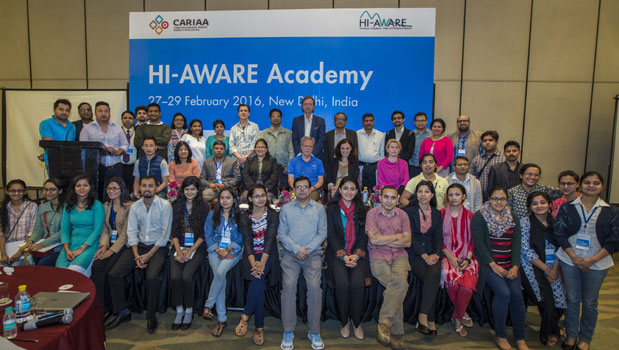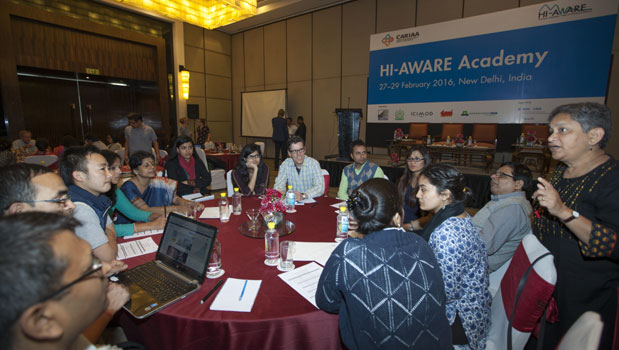By Ashmita Paudel, Sunam Pradhan and Sijal Pokharel
 Participants and facilitators of the HI-AWARE Academy
Participants and facilitators of the HI-AWARE Academy
Photo: Jitendra Bajracharya/ICIMOD
When we received an email from ICIMOD inviting us to join the Climate Change Adaptation Policy and Science (CCAPS) conference and the HI-AWARE Academy in Delhi and Dehradun from 24 February–5 March 2016, little did we know what to expect from the events. After corresponding, we learned that the conference dealt with bridging the gap between science and policy in terms of climate change. It was interesting because as environmental science students and budding environmentalists we often discuss how scientific findings can be used to help improve the lives and livelihoods of affected communities.
We were part of the CCAPS Conference, held in The Grand Hotel in Delhi from 24–25 February. The conference was impressive. It focused on climate change in the Hindu Kush Himalayan region, documented impacts, knowledge gaps between what we already know and what we need to know further, adaptation strategies, and policies from multilevel perspectives. Maladaptation and linking policy-science-practice were also given due importance.
The Academy
 An interactive Academy session being facilitated by governance specialist Rucha Ghate
An interactive Academy session being facilitated by governance specialist Rucha Ghate
Photo: Jitendra Bajracharya/ICIMOD
After the completion of the conference, we got to “attend” the HI-AWARE Academy from 27 February onwards. The Academy was not a physical infrastructure, a school as such, but an abstract institution of HI-AWARE academicians and researchers. It was held in the same venue as the conference in Delhi.
Unlike the conference, which focused on bridging the gap between science and policy, the Academy was aimed specifically at scientists and researchers involved in the HI-AWARE project. The Academy hoped to explain the basics of HI-AWARE research components, inform fellow researchers about ongoing research and progresses, prepare young researchers for effective research skills by teaching field etiquette, research techniques and skills, and facilitate presentations of HI-AWARE fellows and researchers.
The Academy was held in sessions, the first of which was facilitated by David Molden, Director General of ICIMOD, who spoke about the effective use of research in policymaking and implementation. Arun Bhakta Shrestha, senior climate change specialist from ICIMOD, facilitated the second session and spoke about the biophysical drivers of climate change like temperature and precipitation, and about tailoring and downscaling available data to fit a given local perspective. In the third session, Dwijen Mallick from BCAS, Bangladesh, spoke about the socio-economic aspects of vulnerability like poverty, class, gender, inequity and exclusion.
The fourth session was facilitated by ICIMOD’s Chanda Gurung Goodrich, a gender specialist, who talked about gendered vulnerability and addressing gender-related issues in vulnerability assessments. The final session was the most interactive one where Rucha Ghate, governance specialist from ICIMOD, had us engage in a game of marbles reminding most participants of our childhood. Ghate led the game to explain governance and talked about the three principles of management of resources: efficiency, equitability and sustainability. She went on to conclude the session and the day with the remarks: All decision making cannot be centralised, but it cannot be decentralised either.
On the second day of the Academy, we were introduced to a mosaic of ideas about climate change-related issues. The day began with a presentation on ‘Understanding Climate Change Vulnerabilities through Critical Moments’. We learned that critical moments are actually turning points at a certain point of time with high climate risks. In order to understand the vulnerability of people at a certain place it is important to understand three major components: exposure, sensitivity and adaptive capacity with exposure and sensitivity being directly proportional, and adaptive capacity inversely proportional to vulnerability. Vulnerability is further triggered by a critical moment and hence demands adaptation intervention. The identification of critical moments is not less challenging. We can adopt social survey methods like questionnaires, focus group discussions and field visits, among others. Since this entails both social survey and climate science, the community plays a key role in the identification of a critical moment. It is very important to frame correct and focused questions.
Another presentation, on ‘Adaptation Pathways and its Application’, was equally interesting and useful. Adaptation pathways are alternative solutions to or ways out of a problem. After understanding critical moments, we must search for several adaptation pathways to address that problem. There can be several alternatives to a particular critical moment; the understanding of the most suitable pathways and their prioritisation is essential.
The session continued with a presentation on ‘Understanding Decision-making for Adaptation, Multi-criteria Analysis’. As participants, we learnt that adaptation pathways should be weighed before being prioritised. To do this, we take lists of several adaptation pathways, score them under several titles like ‘No Regrets’, ‘Feasibility’ and ‘Sustainability’ and then prioritise the most appropriate. This was indeed great learning. Similarly, the presentation on ‘Trans-disciplinary Research’ gave us insights into global climate change-related issues. More concern at the national as well as international levels needs to be shown for this.
The sessions were followed by presentations by PhD candidates from Nepal, Bangladesh and India. Poster presentations by 16 Masters students from countries like Nepal, Bangladesh and took place next.
The experience
The CCAPS Conference and the HI-AWARE Academy were a great experience for us. The Academy provided us a platform on which to interact with international scientists and researchers. We got the opportunity to pitch in research ideas and get feedback and suggestions in return. The mentoring sessions, in groups and individually, were especially fruitful for graduating students like us who have little exposure to how research actually works. The experience has enabled us to identify our area of interests and focus on one research component of the HI-AWARE. We are much clearer of about the HI-AWARE Research Components and Work Packages as well.
The opportunity to get to listen to the experiences of top-notch scientists was a big one and has helped us comprehend our own responsible towards the communities that help us generate our knowledge. We left the academy as a part of a family. We had made friends and memories, gotten ourselves involved with a large science network and felt more motivated and inspired as a result.
